/category/landscapes/
Utagawa HIROSHIGE II (1829-1869)
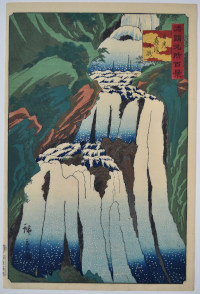
Click here to view image full size.
Nikko Shimofuri no taki, “Shimofuri Waterfall in Nikko” from Shokoku meisho hyakkei, “Hundred Views of Famous Places in the Provinces.” An uncompleted set of 81 prints published by Uoya Eikichi between 1859-1861 (this being 1859).
Fine impression, colour and condition. Signed Hiroshige ga.
Status: Available
Utagawa HIROSHIGE (1797-1858)
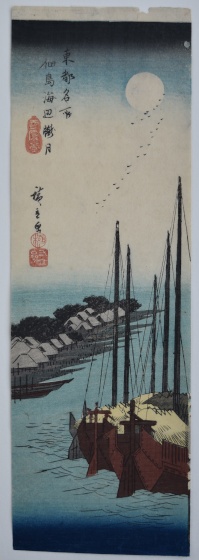
Click here to view image full size.
Spring moon at the shore of Tsukudajima . One of a set of chu-tanzaku prints published by Shogendo, c. 1837. Tsukudajima was one of two islands at the mouth of the Sumida River. Originally a sanbar, it was reclaimed with earth and rocks and given its name by the first Tokugawa Shogun, Ieyasu, who invited thirty-three fishermen to live there in 1613 in order to provide fish for the rapidly expanding city of Edo. The fishermen came from Tsukudama near Osaka and it was they who became the proprietors of what would become the Tsukiji fish market. It must have been popular during the late Edo period as a place to visit and view the boats from teahouses on the shore because there are many prints depicting the area, especially under a full moon.
Fine impression, colour and condition. Signed Hiroshige ga. n.
Status: Available
Utagawa HIROSHIGE (1797-1858)
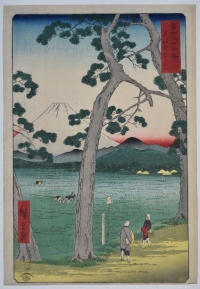
Click here to view image full size.
Tokaido hidari Fuji, “Fuji Seen from the left on the Tokaido [Road]” from Fuji sanjurokkei, “Thirty-six Views of Fuji” published by Tsutaya Kichizo, 1858. Shows travellers on the Tokaido Road at Oiso with workers in rice paddies beyond.
Fine early impression and colour with the red signature and title labels double-printed to give a more saturated colour. Bottom margin trimmed close, otherwise fine condition. Signed Hiroshige ga.
Status: Available
Utagawa HIROSHIGE (1797-1858)
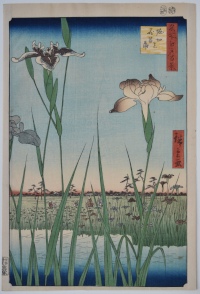
Click here to view image full size.
Horikiri no hana shobu, “Iris Garden at Horikiri” from Meisho Edo hyakkei, “Hundred Famous Views of Edo.” Published by Uoya Eikichi, 1856-58 (this being 1857). Horikiri village on the Arakawa River, north of Edo, was famous for growing irises, chrysanthemums, morning glory and azaleas for the Edo market. One of the most popular prints from the set. Provenance: Purchased from me in 2008.
Fine early impression. Fine colour and condition. Signed Hiroshige ga.
Status: Available
Katsushika HOKUSAI (1760-1849)
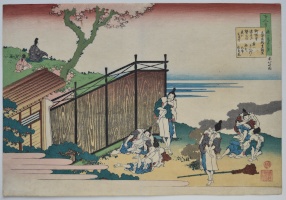
Click here to view image full size.
Hokusai’s interpretation of a poem by Onakatomi no Yoshinobu Ason (921-991). From an unfinished set: Hyakunin isshu uba ga etoki, “Pictures of One Hundred Poems by One Hundred Poets Explained by the Nurse.” The poems are from an anthology Hyakunin isshu, “One Hundred People, One Poem Each” compiled by the poet Fujiwara no Teika (1162-1241). The poet speaks of his love as being like the fire kept by the guards at the gate to the Imperial Palace: It burns hot only at night. There is actually some doubt that the poem can be attributed to Yoshinobu. Shows a group of off-duty Imperial carriage guards relaxing around the smoking embers of a fire. The poet with his servant is seen sitting on the distant hill. Published by Eijudo, 1835-36. A considerable number of original drawings exist for the set that were not turned into prints and are in various museums and private collections.
Fine impression, colour and condition. Signed Saki no Hokusai Manji.
Status: Available
Ichiryusai HIROSHIGE (1797-1858)
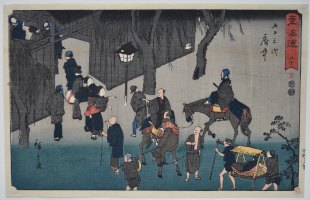
Click here to view image full size.
Fuchu from The Fifty-three Stations of the Tokaido published by Marusei, Maruya Seijiro, 1847-52. Called the Reisho Tokaido because of the angular style of Kanji used. Travellers coming and going at the entrance to the station. One of the best designs from the set. Provenance: Ex Hayashi collection with seal below title cartouche.
Fine impression and colour. Very good condition. Signed Hiroshige ga.
Status: Available
Utagawa HIROSHIGE (1797-1858)
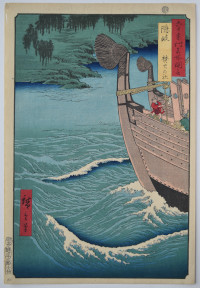
Click here to view image full size.
Oki Province, Takuhi Shrine. From a set of 69 prints [Dai Nihon] Rokujuyoshu meisho zue, “Famous Places in the Sixty-odd Provinces [of Japan]” published by Koshihei between 1853 and 1856, this being 1853. The prows of two boats near the island of Nishinoshima. A torii seen at the top of the print indicates the Takuhi Shrine, one of the most important shrines dedicated to the gods of the sea.
Fine impression and colour. Light album backing, otherwise very good condition. Signed Hiroshige ga.
Status: Available
Utagawa HIROSHIGE (1797-1858)
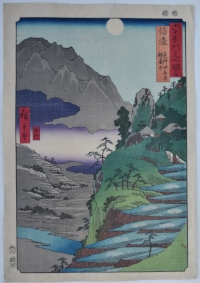
Click here to view image full size.
Shinano, Sarashina tagoto no tsuki, Kyodaisan, “Shinano [Province], the Moon Reflected in the Sarashina Paddy-fields, Mount Kyodai.” This was a popular destination for outings to view the multiple reflections. From a set of 69 prints [Dai Nihon] Rokujuyoshi meisho zue, “Famous Places in the Sixty-odd Provinces [of Japan]” published by Koshimuraya Heisuke between 1853 and 1856, this being 1853.
Fine, early impression. Fine colour and condition with large margins. Signed Hiroshige ga.
Status: Available
Utagawa HIROSHIGE II (1826-1869)
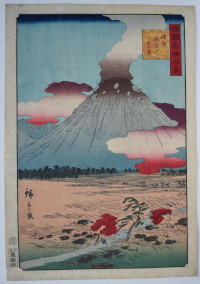
Click here to view image full size.
A view of a smoking Mt Asama, Shinano Province, from Shokoku meisho hyakkei, the “One Hundred Views of Famous Places in the Provinces.” Mt Asama is an active volcano which violently erupted in 1108. Subsequently there was another eruption in 1783 and since then there have been minor tremors. Published by Uoya Eikichi between 1859 and 1861 (this being 1859).
Fine impression, colour and condition. Signed Hiroshige ga.
Status: Available
Utagawa HIROSHIGE (1797-1858)
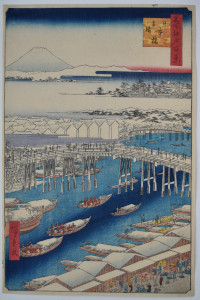
Click here to view image full size.
Nihonbashi yukibare, “The Nihon Bridge, Clear Weather After Snow.” From the set Meisho Edo hyakkei, “One Hundred Views of Edo.” The set published by Uoya Eikichi 1856-58 (this being 1856). The set comprises 118 prints by Hiroshige and another by Hiroshige II. However, three prints are dated 10/1858, the month following Hiroshige’s death and these are thought to be by Hiroshige II as well. They are: Ueno Yamashita, Ichigaya Hachiman and Bikunibashi. Number 1 from the set and a view of the Sumida River with Mt. Fuji in the distance. This is the starting point for the Tokaido Road.
Fine, early impression with gradation on the roofs and on Mt. Fuji. Fine colour. Margins trimmed a little, otherwise very good condition. Signed Hiroshige ga.
Status: Available
Utagawa HIROSHIGE (1797-1858)
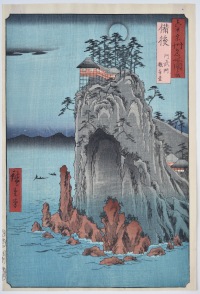
Click here to view image full size.
Bingo, Abuto, Kannondo, “Bingo [Province], Abuto Kannon Temple” from Rokujuyoshu meisho zu, “Famous Views of the Sixty-odd Provinces” published by Koshimuraya Heisuke in 1853-56 (this being 1853). The spectacular position of this small Buddhist temple is at the tip of Cape Abusagi overlooking the Seto Island Sea. This is the first edition with the added cloud top left and extra bokashi. The red signature and title labels are double-printed to give a more saturated colour (also found on early impressions of the Thirty-six Views of Fuji set). Provenance: Purchased from me in 1982.
Fine impression, colour and condition. Signed Hiroshige ga.
Status: Available
Utagawa HIROSHIGE (1797-1858)
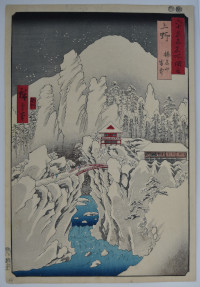
Click here to view image full size.
Kozuke, Harunasan setchu, “Kozuke [Province], Mount Haruna Under Snow.” From a set of 69 prints [Dai Nihon] Rokujuyoshi meisho zue, “Famous Places in the Sixty-odd Provinces [of Japan]” published by Koshihei between 1853 and 1856, this being 1853. A red bridge spans a gorge with precipitous cliffs and a fast flowing river. Fantastic crags point upwards into the sky. In the distance is Mount Haruna – a sleeping volcano.
Very fine impression and colour. Light album backing, otherwise fine condition. Signed Hiroshige ga.
Status: Available
Utagawa HIROSHIGE (1797-1858)
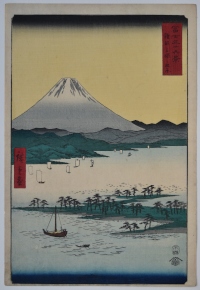
Click here to view image full size.
Suruga, Miho no Matsubara, “Pine Beach of Miho in Suruga [Province]” from Fuji sanjurokkei, “Thirty-six Views of Fuji” published by Tsutaya Kichizo, 1858. A striking design with the yellow sky and one of the best prints from the set. The Miho peninsula has a seven-kilometre seashore lined with pine trees.
Fine early impression and colour with the red signature and title labels double-printed to give a more saturated colour. Fine condition. Signed Hiroshige ga.
Status: Available
Utagawa HIROSHIGE (1797-1858)
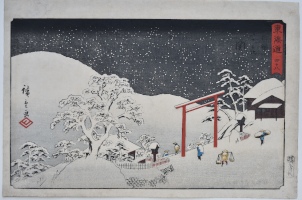
Click here to view image full size.
Seki from a Tokaido set published by Maruya Seijiro, 1850-51, hence it is often referred to as the Marusei Tokaido. Also known as the Reisho Tokaido because the title “Tokaido” is written in formal script. Below is the station number 48. Seki was located where the two highways of Tokaido and Ise-ji meet. Seki means “barrier checkpoint.” Figures pass beneath a torii gate on a snowy hillside.
Fine impression and colour. Minor edge soil, otherwise very good condition. Signed Hiroshige ga.
Status: Available
Utagawa HIROSHIGE (1797-1858)
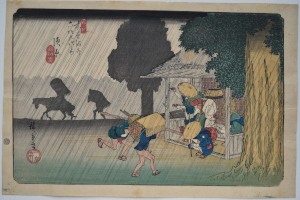
Click here to view image full size.
Station Suhara from Kisokaido rokujukyu tsugi no uchi, “Sixty-nine Stations of the Kisokaido” published by Kinjudo, 1834-1842. The road known as the Nakasendo, “central mountain route,” as opposed to the Tokaido which was the “eastern sea route” was started with Keisai Eisen and finished by Hiroshige who designed 47 prints. This is one of Hiroshige’s most famous designs. Shows travellers sheltering in a wayside shrine from heavy rain with two figures running for its shelter. In the distance, silhouetted, a figure on horseback, another following on foot. Hiroshige based his design on an illustration in Itcho gafu, “Itcho’s Picturebook” by Suzuki Rinsho, 1770. This station is famous for the number of variant states, some lighter, some darker, and variations in the gradation on the trees as the printers strove to capture this stormy scene. This is an early state.
Fine impression with crisp seals. Fine colour and condition with large margins. Signed Hiroshige ga.
Status: Available
Utagawa HIROSHIGE (1797-1858)
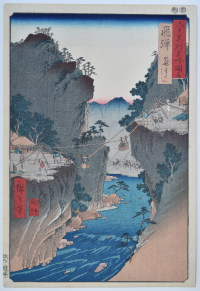
Click here to view image full size.
Hida, kago-watashi, “Basket Ropeway in Hida [Province]” from a set of 69 prints [Dai Nihon] Rokujuyoshi meisho zue, “Famous Places in the Sixty-odd Provinces [of Japan]” published by Koshihei between 1853 and 1856, this being 1853. Originating in China, Japan and northern India, travellers could cross deep ravines by suspending themselves in a harness which evolved into a basket.
Very fine impression and colour. Light album backing, otherwise fine condition. Signed Hiroshige ga.
Status: Available
Utagawa HIROSHIGE II (1826-1869)
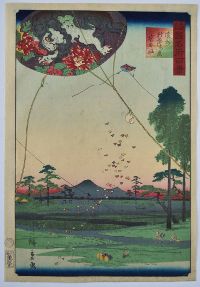
Click here to view image full size.
Enshu Akiba enkei Fukuroi tako. Fukuroi, Enshu (Totomi) Province from the “Hundred Views of Famous Places in the Provinces.” An uncompleted set of 81 prints published by Uoya Eikichi between 1859 – 1861 (this being 1859). Shows kite flying with a distant view of Mount Akiba. It has been suggested that the release of confetti was to bring good luck for the forthcoming harvest.
Very fine impression of the first edition. Fine colour. Very slight soil, otherwise fine condition. Signed Hiroshige ga.
Status: Available
Utagawa HIROSHIGE (1797-1858)
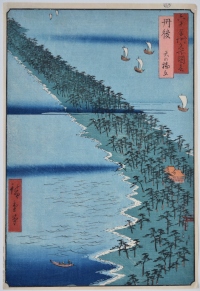
Click here to view image full size.
Tango, Ama no hashidate, “Tango [Province], Ama no hashidata” from Rokujuyoshu meisho zu, “Famous Views of the Sixty-odd Provinces” published by Koshimuraya Heisuke in 1853-56 (this being 1853). Shows the “Heaven’s Bridge” peninsula of pine trees extending into Miyazu Bay. One of the Nihon sankei, “Three Famous Views of Japan.”
ga.
Very good impression and colour. (The success of this print depends entirely on the bokashi clouds wiped across the design: Impressions vary depending on the dexterity of the printer.) Margins trimmed, otherwise very good condition. Signed Hiroshige ga.
Status: Available
Utagawa HIROSHIGE (1797-1858)
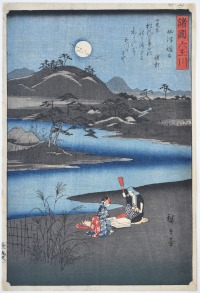
Click here to view image full size.
The Kinuta (or Toi) river in Settsu Province from Shokoku Mu Tamagawa, “Six Crystal Rivers in Various Provinces.” Published by Maruya Kyushiro, 1857. Shows two women fulling cloth beneath a full moon. An autumnal night activity. Kinuta is the name given to the mallet used to beat the cloth.
Fine impression and colour. Small repair top left corner and slight edge soil, otherwise good condition. Signed Hiroshige ga.
Status: Available
Utagawa HIROSHIGE (1797-1858)
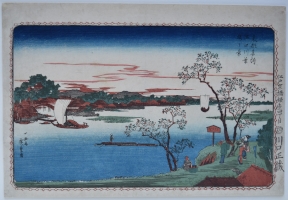
Click here to view image full size.
Sumidagawa hazakura no kei, “Cherry Trees along the Sumida River” from a Toto meisho “Famous Places in the Eastern Capital” set of ten prints published c 1831-2 by Kawaguchiya Shozo. Hiroshige’s first landscape set. The first editions, as here, have decorative borders adding a western element into the design. These were removed on later editions. There are also variant states with different shading. Rare.
Fine impression and colour. Backed, otherwise very good condition. Prints from this set are often missing or have the publisher’s name and address on the right border trimmed. Signed Ichiyusai Hiroshige ga. (The last set to be signed like this.)
Status: Available
Utagawa HIROSHIGE (1797-1858)
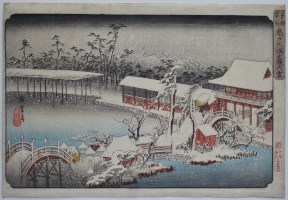
Click here to view image full size.
Kameido Tenmangu keidai no yuki, “The Compound of the Tenman Shrine at Kameido in Snow.” From a set of twenty-one prints Toto meisho, “Famous Views in the Eastern Capital” published by Sanoya Kihei, c 1834-5. The series was extended to fifty-five in c 1839-42. One of the most famous places in Edo. Known for its pergola, two drum bridges, koi ponds and the wisteria which flowered in the fifth month. The main shrine is dedicated to the memory of Sugawara no Michizane (Tenjin), the father of Japanese learning and built in 1662. The design comes in various states: Late editions have a black sky and the red publisher’s seal on right margin is replaced with an abbreviated Sanoki seal in black. Even later editions show a slipping plug becoming evident on the edge of the water, centre left.
Fine impression and colour. Probably the earliest printing. Slight trimming on right margin, otherwise very good condition. Signed Hiroshige ga.
Status: Available
v
Ichiryusai HIROSHIGE (1797-1858)
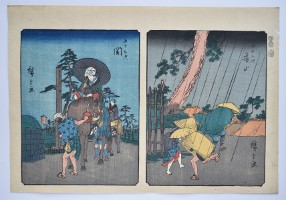
Click here to view image full size.
Seki and Kameyama from the chuban Muraichi Tokaido. The set of 56 prints published by Muraichi, 1852. Printed two-to-a-sheet uncut and probably from a complete proof set. Double censor’s seals Murata and Kinugasa and date seal 2ic/1852 top right.
Fine impressions with strong woodgrain showing. Fine colour. Very small binding holes in right border, otherwise fine condition. Signed Hiroshige ga on each print.
Status: Available
Utagawa KUNIYOSHI (1797-1861)
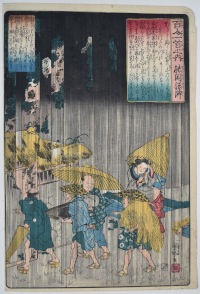
Click here to view image full size.
A poem by the celebrated poet and monk Noin-hoshi from the series Hyakunin isshu no uchi, “One Hundred Poems for One Hundred Poets” which was compiled in 1235 by Fujiwara Teika (1162-1241). A group of travellers are caught in a torrential downpour. One of the best designs in the set published by Ebisuya Shoshichi, Ebine, 1840-42. Only 58 of the 100 are known. Various translations of the poem exist, here is one:
The maples and leaves
Of Mount Mimura –
Making the Tatsuta River
A fine brocade
Very fine impression. Fine colour. Slight nibbling on one margin, otherwise fine condition. Signed Ichiyusai Kuniyoshi ga.
Status: Available
Utagawa KUNIYASU (1794-1832)
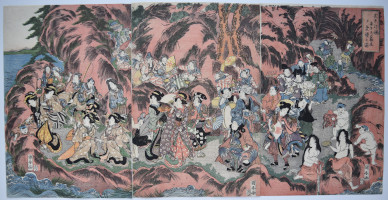
Click here to view image full size.
A triptych Soshu Enoshima Benzaiten Iwaya narabi sairei no zu, “Picture of Iwaya, the Main Shrine, Pilgrims to the Display of Benzaiten at Enoshima.” Enoshima island was a popular place to visit with the Iwaya caves and the shrine of the Buddhist goddess Benzaiten (Benten), goddess of the arts, entertainment and wealth, and one of the Seven Gods of Good Fortune. A fascinating print showing a multitude of various visitors. Published by Kawaguchiya Uhei, late 1820s. Rare.
Fine impression, colour and condition. Signed Kuniyasu ga.
Status: Available
Utagawa HIROSHIGE (1797-1858)
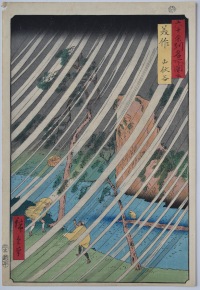
Click here to view image full size.
Mimasaka, Yamabushidani, “Mimasaka [Province], Yamabushi Valley.” Travellers caught in heavy wind and rain in the valley. Hiroshige II also produced an excellent version of this design. From a set of 69 prints [Dai Nihon] Rokujuyoshi meisho zue, “Famous Places in the Sixty-odd Provinces [of Japan]” published by b Koshimuraya Heisuke between 1853 and 1856, this being 1853.
Very fine impression and colour. Light album backing and very small wormhole at extreme edge of margin, top left, otherwise fine condition. Signed Hiroshige ga.
Status: Available
Utagawa HIROSHIGE (1797-1858)
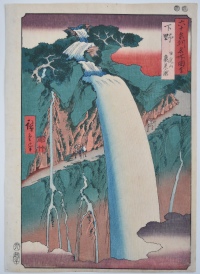
Click here to view image full size.
Shimotsuke Nikkosan urami no taki, “Back-viewed Waterfall on Mt. Nikko in Shimotsuke [Province].” From a set of 69 prints [Dai Nihon] Rokujuyoshi meisho zue, “Famous Places in the Sixty-odd Provinces [of Japan]” published by Koshihei between 1853 and 1856, this being 1853. Figures gaze up at the back of the waterfall which thunders over the path. It is also known with variant colour schemes. Fine design.
Very fine impression with strong blind-printing on the fall. Fine colour and condition. Full size. Signed Hiroshige ga.
Status: Available
Utagawa HIROSHIGE (1797-1858)
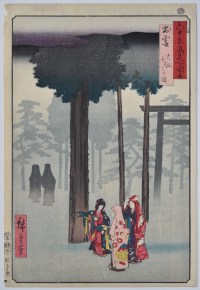
Click here to view image full size.
Izumo, taisha Hotohoto no zu, “Izuma [Province], Hotohoto Festival at Izumo Shrine.” Shows pilgrims to the oldest Shinto shrine in Japan. A heavy mist scene with the torii gate seen to the right. Every year from the 11th to the 17th day of the 10th lunar month (usually November) all Shinto’s deities from around Japan supposedly assembled here. It is also the shrine to visit in the hope of finding a partner. From a set of 69 prints [Dai Nihon] Rokujuyoshi meisho zue, “Famous Places in the Sixty-odd Provinces [of Japan]” published by Koshimuraya Heisuke between 1853 and 1856, this being 1853.
Very fine impression and colour. Light album backing and very small wormhole at extreme edge of margin, top left, otherwise fine condition. Signed Hiroshige ga.
Status: Available
Utagawa HIROSHIGE (1797-1858)
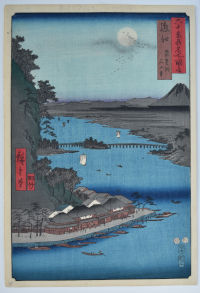
Click here to view image full size.
Omi, Biwako Ishiyamadera, “Ishiyama Temple and Lake Biwa in Omi [Province].”From a set of 69 prints [Dai Nihon] Rokujuyoshi meisho zue, “Famous Places in the Sixty-odd Provinces [of Japan]” published by Koshihei between 1853 and 1856, this being 1853. Moonlight on Lake Biwa is one of the iconic Eight Views of Omi.
Very fine impression and colour. Light album backing, otherwise fine condition. Signed Hiroshige ga.
Status: Available
Utagawa HIROSHIGE (1797-1858)
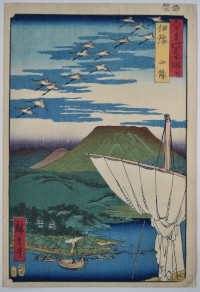
Click here to view image full size.
Iyo Province, Saijo. From a set of 69 prints [Dai Nihon] Rokujuyoshu meisho zue, “Famous Places in the Sixty-odd Provinces [of Japan]” published by Koshihei between 1853 and 1856, this being 1853. A large furled sail in the foreground with Saiju village on the water’s edge. Beyond is Mt. Ishizuchi.
Fine impression and colour. Light album backing, otherwise very good condition. Signed Hiroshige ga.
Status: Available
Utagawa HIROSHIGE (1797-1858)
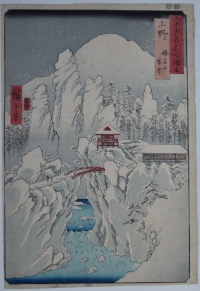
Click here to view image full size.
Kozuke, Harunasan setchu, “Kozuke [Province], Mount Haruna Under Snow.” From a set of 69 prints [Dai Nihon] Rokujuyoshi meisho zue, “Famous Places in the Sixty-odd Provinces [of Japan]” published by Koshihei between 1853 and 1856, this being 1853. A red bridge spans a gorge leading to the Buddhist Haruna shrine. Below is a fast flowing river with precipitous cliffs. Fantastic crags point upwards into the sky and in the distance is the dormant volcano Mount Haruna.
Good impression and colour. Slight soil on bottom left margin, otherwise good condition. Signed Hiroshige ga.
Status: Available
Utagawa HIROSHIGE (1797-1858)
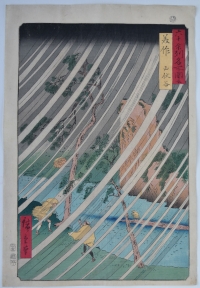
Click here to view image full size.
Mimasaka, Yamabushidani, “Mimasaka [Province], Yamabushi Valley.”A high wind and rain in the valley with a man on a raft on the Yoshi River. Other figures in the foreground, one having lost his hat. From a set of 69 prints [Dai Nihon] Rokujuyoshi meisho zue, “Famous Places in the Sixty-odd Provinces [of Japan]” published by Koshimuraya Heisuke between 1853 and 1856, this being 1853.
Fine, early impression. Fine colour and condition with large margins. Signed Hiroshige ga.
Status: Available
Utagawa KUNIYOSHI (1797-1861)
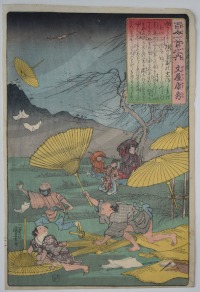
Click here to view image full size.
A poem by the celebrated poet Bunya no Yasuhide from the series Hyakunin isshu no uchi, “One Hundred Poems for One Hundred Poets” which was compiled in 1235 by Fujiwara Teika (1162-1241). The poet in the background watches as a fierce wind blows away some of the umbrellas that are being made. One of the best designs in the set published by Ebisuya Shoshichi, Ebine, 1840-42. Only 58 of the 100 are known. Various translations of the poem exist, here is one:
The mountain wind in autumn time
Is well called “hurricane”;
It hurries canes and twigs along,
And whirls them o’er the plain
To scatter them again
Very fine impression. Fine colour. Slight nibbling of border but otherwise fine condition. Signed Ichiyusai Kuniyoshi ga.
Status: Available
Shotei HOKUJU (Active 1787-1818)
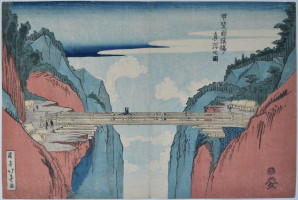
Click here to view image full size.
Kai no kuni Saruhashi no shinsha no zu, “A True View of the Monkey Bridge in the Province of Kai.” An impressive wooden bridge spans a deep chasm. It was called the “Monkey Bridge” because the original rickety plank structure was so precarious that only an agile monkey could cross it. Hokuju produced a number of these westernised landscapes and this is one of the best designs. Published by Nishimuraya Yohachi, c 1815. It is also known with variant colour schemes.
Very good impression and colour. Slightly trimmed around and imperceptible centre fold. Signed Shotei Hokuju ga.
Status: Available
Utagawa KUNIYOSHI (1797-1861)
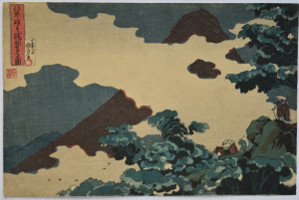
Click here to view image full size.
Travellers viewing Mount Asama. Usui-toge yori Asama o miru zu, “A View of Mount Asama from Usui Pass.” From Kuniyoshi’s best landscape set. Of the utmost rarity with most extant impressions differing. This and the impression in the Museum of Fine Arts, Boston, are similar, without the smoke coming from the cone of Asama (the most active volcano on Honshu). Other impressions are in: The British Museum, 1948, 0410, 0. 108, which has gradation up the left side of the mountain; the Metropolitan Museum of Art, JP 1424, which has gradation down from the summit; and Worcester Art Museum which is similar to the Mets, 1901. 692. Published by Yamaguchiya Tobei, c. 1836.
Very good impression, colour and condition. Signed Ichiyusai Kuniyoshi ga.
Status: Available
Ichiryusai HIROSHIGE (1797-1858)
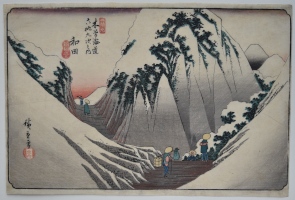
Click here to view image full size.
Wada from the Sixty-nine Stations f the Kisokaido. The set was started by Eisen and published by Hoeido in 1835, but in 1837 Hiroshige took over and completed the series with the publisher Iseiri (Kinjudo). Wada is the highest point on the Kisokaido and Hiroshige shows travellers traversing the snow covered pass.
Very good impression and colour. Minimal edge soil and trimming, otherwise very good condition. Signed Hiroshige ga.
Status: Available
Utagawa HIROSHIGE II (1826-1869)
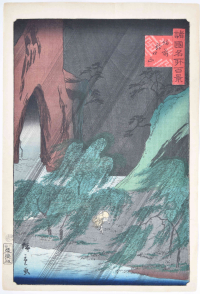
Click here to view image full size.
The Dragon’s Maw Mountain, Bizen Province, Bizen tatsu-no-kuchiyama from an unfinished set Shokoku meisho hyakkei, “One Hundred Views of Famous Places in the Provinces” published by Uoya Eikichi between 1859 and 1861 (this being 1860). Shows a lone figure battling a heavy rainstorm in a steep-sided canyon.
Fine impression, colour and condition. Signed Hiroshige ga.
Status: Available
Utagawa HIROSHIGE (1797-1858)
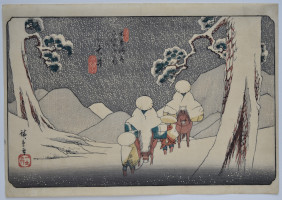
Click here to view image full size.
Oi, a suburb of present day Ena City, is in the southern foothills of the central mountain range now known as the Japan Alps. Shows a group of travellers heavily protected against the snow and cold. From Kisokaido rokujukyutsugi no uchi, “Sixty-Nine Stations of the Kisokaido.” The set of seventy prints was started by Eisen and published by Hoeido in 1835, but in 1837 Hiroshige took over and completed the series with the publisher Iseya Rihei (Kinjudo). One of Hiroshige’s most famous designs.
Very good impression and colour. Imperceptible centre fold, otherwise very good condition. Signed Hiroshige ga.
Status: Available
Utagawa HIROSHIGE (1797-1858)
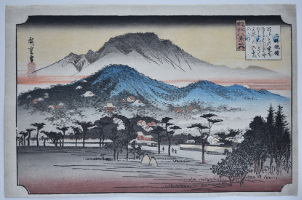
Click here to view image full size.
Mii no bansho, “Evening Bell at Miidera Temple” from a set Omi hakkei no uchi, “Eight Views in Omi [Province].” Shows the temple hidden amongst hills on the southern side of Lake Biwa. Miidera is the common name for the Onjoji, a temple of the Tendai sect founded in 858. Published by Hoeido and Eikyudo in c. 1834-5. The “Eight Views” theme was derived (as so much else in Japanese art) from China and based on the Eight Views of Xiaoxiang paintings of the 11th century. The subject was transposed to Omi and then taken up by such artists as Harunobu, and later Hiroshige. It was often playfully alluded to in sets of eight prints in mitate-e style.
Very good impression, colour and condition, Signed Hiroshige ga.
Status: Sold
Utagawa HIROSHIGE (1797-1858)
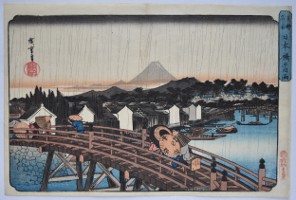
Click here to view image full size.
Nihonbashi no hakuu, “Light Rain on Nihon Bridge.” From a Toto meisho set of 21 designs published between c. 1832 and 1839 by Kikakudo. The set was subsequently enlarged. Shows figures crossing Nihonbashi in rain, one figure carries an umbrella with the publisher’s name. Warehouses in the background and a distant view of Fuji. A beautiful print and very difficult to find in early impression: The title cartouche had a plug inserted beside the bottom three characters of the title on the left. This damage seems to have occurred when the block was cut and over time the spigot gradually slipped out leaving an unprinted area (which is sometimes painted in). In the earliest impressions the plug is hardly visible (as here). Also, the publisher’s seal at the bottom right should be in red, later editions having it in black. There was also an early variant edition with a yellow sky.
Fine impression and colour. Imperceptible centre fold, also near the right edge, otherwise very good condition. Signed Hiroshige ga.
Status: Sold
Utagawa HIROSHIGE (1797-1858)
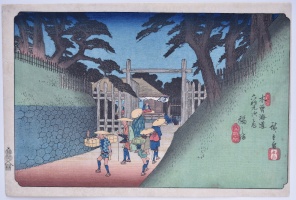
Click here to view image full size.
Station Fukushima from Kisokaido rokujukyutsugi no uchi, “Sixty-nine Stations of the Kisokaido.” The set of seventy prints was started by Eisen and published by Hoeido in 1835, but in 1837 Hiroshige took over and completed the series with the publisher Iseya Rihei (Kinjudo). Fukushima was one of the four most important checkpoints in the country and travellers had to have their documents inspected and approved before they could continue.
Superb impression. Very fine colour. Fine condition. Signed Hiroshige ga.
Status: Sold